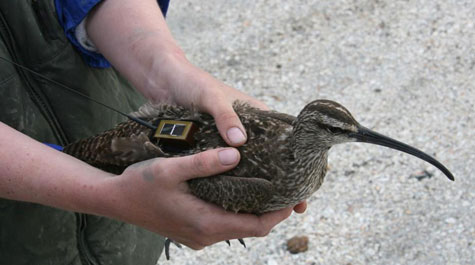National news highlights bird's heroic flight
Diane Sawyer said it best: “Better bet on the bird.”
The bird, in this case, is a whimbrel named Chinquapin who flew through the most dangerous part of Hurricane Irene and emerged with scarcely a ruffled feather. Chinquapin’s feat was a bright spot in the otherwise cloudy national coverage of Hurricane Irene and its aftermath. The gallant whimbrel was featured in media ranging from USAToday to Sawyer’s ABC News.
Researchers at the Center for Conservation Biology (CCB) have been tracking the movements of Chinquapin and several other whimbrels for the past few years. The scientists net the birds on the Eastern Shore and fit them with solar-powered transmitters before releasing them.
Bryan Watts, director of the Center for Conservation Biology, says whimbrels are extreme fliers, migrating from breeding grounds in the high Arctic to winter habitat in Central and South America. Early in August, a whimbrel named Hope successfully survived passage through the teeth of Tropical Storm Gert, a rare tropical storm off Nova Scotia. Hope encountered high headwinds for 27 hours, averaging only 9 miles per hour. Once through the storm, her flight speed increased to more than 90 miles per hour as the bird was pushed by significant tail winds and made it back to Cape Cod. Hope now is resting on her Eastern Shore staging grounds.
Watts said that he’s at a loss to explain exactly what makes whimbrels such excellent storm navigators. “It’s pretty amazing that Hope could withstand headwinds for 27 hours,” he said.
The Eastern Shore is kind of a hub for the long-flying whimbrels, Watts said. They rest there for a few weeks on both northward and southward migrations, recharging on the copious numbers of crabs in the tidal creeks and marshes.
Satellite tracking revealed that Chinquapin left upper Hudson Bay on Aug. 20 and entered Hurricane Irene’s northeast quadrant—the most severe part of the storm—on Aug. 24. CCB Research Biologist Libby Mojica explained that Chinquapin’s transmitter gives location only once every 48 hours, so it wasn’t until 4:20 p.m. on Aug. 26 that researchers were able to determine that Chinquapin was alive and well on Eleuthera Island in the Bahamas.
The researchers expect Chinquapin to rest a while before heading to his wintering grounds in Brazil.
The CCB is a joint program of the College of William and Mary and Virginia Commonwealth University.
This tracking project is a collaborative effort between the Center for Conservation Biology, Georgia Department of Natural Resources, The Nature Conservancy, the U.S. Fish and Wildlife Service, the Virginia Coastal Zone Management Program and Manomet Center for Conservation Sciences.
















